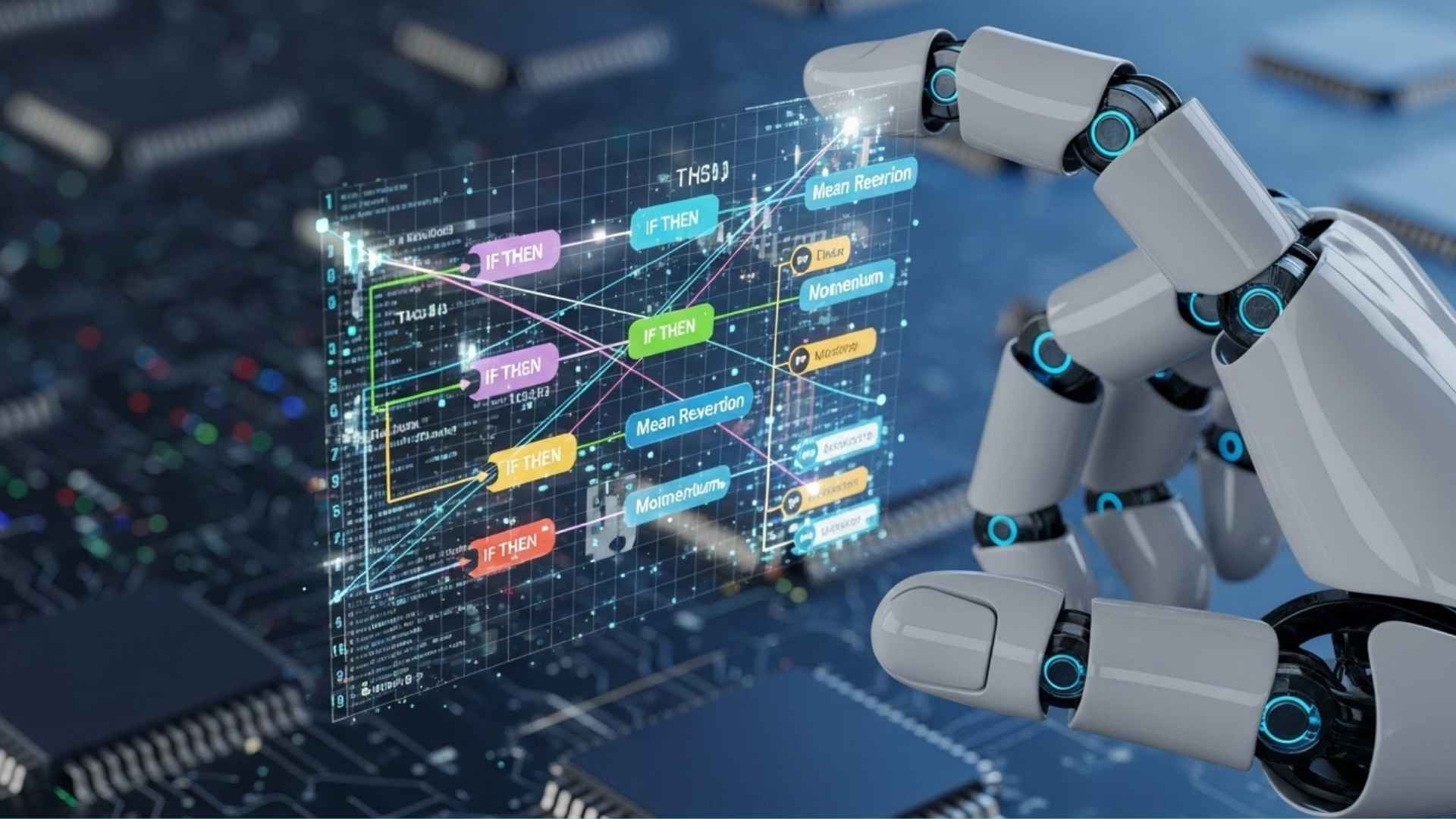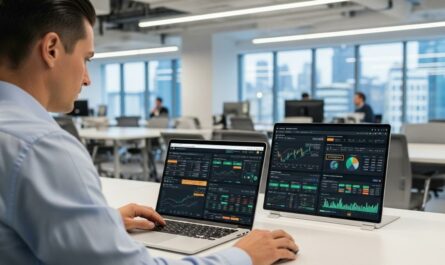What is Algorithmic Trading?
Algorithmic trading has completely changed the financial markets. It is a method of automated trading of stocks and currencies using advanced mathematical formulas (Algorithms).
This system makes the trading process much faster and eliminates the need for human intervention, as the machine automatically makes decisions based on strategies such as price, volume and timing.
While Algorithmic Trading has improved the speed and efficiency of traditional trading methods, it also has its own challenges and risks.
How Algorithmic Trading Changed the Financial Markets
The use of algorithms in trading has been growing since the introduction of computers to the U.S. financial markets in the 1970s.
In 1976, the New York Stock Exchange (NYSE) introduced a system that routed traders’ orders to experts on the exchange floor.
Over the next decade, financial exchanges increased their ability to accept electronic trading, and by 2009, computers were processing more than 60% of all trades in the United States.
Different Types of Algorithmic Trading
Algorithms used in financial trading are rules or instructions designed to make trading decisions automatically.
These systems range from simple stock-by-stock trading systems to more complex black-box algorithms that analyze market conditions, price movements, and other financial data to calculate the best time to trade at the lowest cost and highest profit.
The field of computer engineering and finance is a complex one, so we won’t bore you with too many words. While some of the terminology may vary slightly from one trading firm to another, the following points should give you an idea of how widely Algorithmic Trading is used.
- Arrival Price Algorithms – This method aims to trade as close to the original stock price as possible at which the order was placed. This is useful for reducing the risk of price movements after the order is placed.
- Basket Algorithms – Trades are made while calculating the impact on other securities in the portfolio that are being monitored. For example, if the price is correct but increases the risk of the portfolio, the calculation may stop the trade.
- Implementation Shortfall Algorithms – These automated rules aim to minimize the difference between the price determined and the actual cost of the trade (implementation shortfall).
- Percentage of Volume – Adjusts the order size based on the current volume of the market. It is used to maintain a certain percentage of the total market volume and to balance the impact of trading on the market.
- Single-Stock Algorithms – This method is designed to optimize trading of a single stock, taking into account factors such as market conditions and order size.
- Volume Weighted Average Price (VWAP) – This method tries to trade at a price that is as close as possible to the weighted average of the stock’s trading volume over a given period of time.
- Time Weighted Average Price (TWAP) – This method tries to distribute trades evenly over a specified period of time, aiming to obtain a price that is consistent with the time weighted average of the price. It is used to minimize market impact when executing large volume orders.
- Risk-aversion Parameter – This parameter can be changed depending on the trader and the strategy required. However, it is often used in conjunction with other algorithmic methods to adjust the intensity of trading based on the risk tolerance of the trader or buyer.
Algorithmic Trading in Action
Let’s look at a simple example of how an algorithmic trading system works.
Imagine that you have a rule programmed into your computer to buy 100 shares of XYZ Company stock. The rule is that you will buy when the 75-day moving average crosses above the 200-day moving average.
This phenomenon is called a “Bullish Crossover” in technical analysis, and it usually indicates that the stock price is likely to rise.
Your Execution Algorithm will constantly monitor these average prices and automatically execute the trade as soon as this threshold is met. This eliminates the need for you to constantly monitor the market, and allows you to trade according to the set rules in a precise and emotionless manner. This is the essence of Algorithmic Trading.
Trading Secrets: The World of Black Box Algorithms
Black box algorithms have become a major topic of controversy in the use of artificial intelligence (AI) in the financial markets because of their unique features. The term ‘black box’ refers to a type of calculation whose internal workings are secret and cannot be disclosed.
While simple algorithms follow a set of rules, the distinguishing feature of black box systems is their goal-oriented approach. This means that after the designers set the goal, the algorithm automatically determines the best way to reach the goal based on market conditions.
The public often confuses true black box systems with company secret trading strategies. True black box algorithms, especially those that use AI and machine learning, are characterized by decision-making patterns that are incomprehensible even to the designers. While the results of these systems can be measured, it is difficult to know the exact process by which decisions are made.
This lack of transparency is an advantage in that it allows for the creation of complex and flexible strategies, but it also poses a disadvantage in terms of legal and ethical liability issues, as the reasons behind the decisions are unclear. Since liability must be linked to reasons, this lack of clarity raises questions about risk management for investors.
However, black box algorithms are popular in advanced investment strategies such as high-speed trading (HFT) because they can provide better performance than simple rules-based methods. These systems remain at the forefront of technological research as fintech companies seek to apply advances in AI and machine learning to financial trading.
The Rise of Open Source in Algorithmic Trading
Just as smartphone apps and advanced artificial intelligence (AI) systems have enabled non-experts to create their own applications, the world of algorithmic trading has also seen outsiders participate in expanding their own creations. This open source approach has allowed individual traders and hobbyist programmers to enter a field that was previously only open to experts.
Hedge funds and investment firms (such as Two Sigma and PanAgora) have sometimes profited from this shift. They crowdsource algorithms and, in turn, release parts of their improvements to open source applications, thereby giving back to the programming community. They also hold contests where hobbyist programmers submit their trading algorithms, and award prizes or recognition to the most profitable creations.
Fintech companies are also increasingly using open source to solve problems and connect with the community. According to a November 2023 report by the Fintech Open Source (FINOS) Foundation, about a quarter of financial services professionals are involved in open source data science and AI/machine learning platforms.
However, there are limits to how far this can be scaled in the financial sector. Nearly two-thirds of those surveyed by FINOS expressed concerns about using open source systems due to the need to protect proprietary knowledge.
Advantages and Disadvantages of Algorithmic Trading
Algorithmic trading has both benefits and challenges for the financial markets. Here are some of the main advantages and disadvantages of this system:
Advantages
Anonymity: Because trades are executed by computers and systems, orders are no longer openly visible on the trading floor as they used to be. Additionally, some algorithms can split large trades, making it difficult to identify the participants.
Backtesting and Research: Algorithms can be tested on historical data to verify their effectiveness before being used in the real market, reducing potential losses.
Emotionless Decision-Making: It removes emotional and psychological information from trading, allowing for a more disciplined approach.
Greater Control: Traders can decide all the details of where, when, how much, and how much time they will trade, and can make immediate adjustments or cancellations if necessary.
Less Information Leakage: Brokers no longer receive detailed information about the investor’s orders, reducing the risk of information leakage. Investors only need to communicate the necessary trading information and instructions through the algorithm’s specifications.
Market Access: It allows for faster access to the markets through high-speed networks. In addition, even buyers who do not have access to advanced systems can benefit from these technologies.
Potential for Increased Transparency: While black-box algorithms have their challenges, when trading rules are shared in advance, investors can know exactly how their shares will trade in the market.
Precision: Reduces the risk of human error and is able to execute orders under specific conditions.
Speed and Efficiency: Since algorithms can execute orders at a much faster rate than humans, traders can take advantage of market opportunities more quickly.
Disadvantages
Complacency: Traders can become overly reliant on familiar algorithms, ignoring changing market conditions.
Complexity: This technology is notoriously complex. Additionally, the sheer number of algorithms available (some of which have movie-like or funny names) further complicates the system. When large firms work with multiple brokers, each broker offers a different algorithm, which can be confusing.
Technological Dependence: Reliance on computer systems can lead to losses due to glitches or network connectivity issues, and can lead to missed market opportunities.
Cost: Building and operating algorithmic trading systems is expensive. There are also ongoing costs for network power, hardware, and applications.
Historically Optimized: Algorithms can be intricately designed to match historical data, but they can fail in real-world market conditions.
Price Discovery Challenges: The shift from traditional experts to algorithm-based trading has made price discovery more complex. Algorithms can effectively take into account price data, but they can struggle to quickly determine the fair market value of a security.
Compliance Risks: The system needs to be constantly monitored and adjusted as the rules for automated trading change.
Rigidity in the face of events: Algorithms perform exactly as they are programmed to. Therefore, they can be problematic if market events for which they were not designed occur. This can lead to lower performance and increased costs.
Illiquidity: Another disadvantage of algorithmic trades is that they can quickly lead to liquidity crunch. For example, algorithmic trading was identified as a major factor in the liquidity crunch in financial markets after the Swiss franc was de-pegged to the euro in 2015.
Systemic Risk: There are concerns that the widespread use of similar algorithms can increase systemic risk and market volatility. For example, the “Flash Crash” on May 6, 2010, when indices including the Dow Jones Industrial Average suddenly fell 1,000 points and then quickly recovered, is often cited as an example of systemic risk.
How to Start Algorithmic Trading
If you are interested in Algorithmic Trading and want to get started, there are some key steps you need to follow.
First, you need to learn programming. The most commonly used languages are C++, Java, and Python. Second, you need to understand the fundamentals of the financial markets and start creating or choosing your own trading strategy.
Once you have your strategy, you need to backtest it using historical data before entering the real market. Once you are satisfied with the results of the testing, you need to start implementing your system in practice through a brokerage that supports Algorithmic Trading.
In addition, there are open source platforms where programmers and traders share software, discuss, and give advice to beginners.
How Much Money Do I Need to Start Algorithmic Trading
The amount of money you need to start algorithmic trading can vary greatly, depending on the strategy you use, the type of brokerage you choose, and the types of markets you trade.
How is High-Frequency Trading (HFT) Different from Algorithmic Trading
High-Frequency Trading (HFT) is actually a form of Algorithmic Trading. Its distinguishing feature is that it involves making large numbers of trades at very high speeds.
HFT systems use high-speed network connections, high-performance computer systems, and black-box algorithms to trade stocks at very high speeds (as fast as one-tenth of a millionth of a second).
Also Read: AI in Banking: What It Is and Why It Matters
The Bottom Line
Algorithmic trading offers significant advantages to the financial markets. The main benefits are faster execution, reduced human error, and greater trading efficiency. Traders benefit from less emotional decisions and more precise actions, allowing them to take full advantage of market opportunities.
However, relying on such advanced technology also carries risks. Losses can occur due to system failures or technical problems. In addition, algorithmic trading can increase market volatility and systemic risk, as has been clearly seen in events such as the “Flash Crash”.
To effectively mitigate these risks, users of the system need to constantly monitor changing market conditions and regulatory changes.



